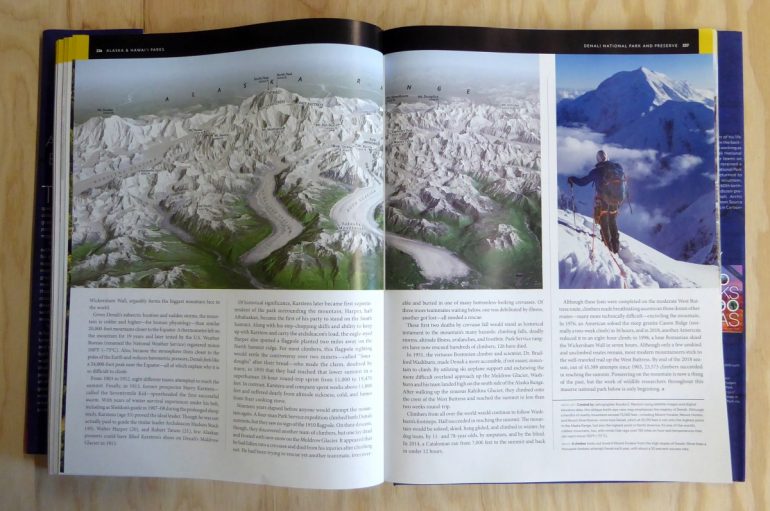A book as extensive as the National Parks it celebrates
Like many of you outdoorsy types, I’ve spent a significant portion of my life within the boundaries of our United States National Parks. Wonderful times, majestic memories: climbing in Yosemite; Denali expeditions; leading youth groups in Arches; Rainier; Big Bend as a child with my adventurous father. I could go on. When I think about those times, along with my rush of nostalgia I allow myself a frisson of patriotism. Starting with Yellowstone Park in 1872, the United States has designated 61 of these icons — comprising a nearly incomprehensible 84 million acres. They range from the tundra of the arctic to the sands of the Sonoran desert, mostly celebrating the natural world, with a bit of history thrown in for good measure (e.g., Mesa Verde).
I was thus excited when Jon Waterman came out with his new book, “Atlas of the National Parks.”
Jon’s coffee table Atlas holds 431 pages with so many stunning images, maps and other illustrations you’ll have a hard time getting to the text. Persevere, as Waterman’s well researched and crisply written prose is uncluttered and to the point — a joy to read in either short bursts or lengthy sit-downs.
I can see myself reciting a section to my bride as we drive to a park we’ve been inspired to visit. Perhaps we’ll pick a destination we’d never known existed and now find fascinating. How about Indiana Dunes, one of our newest parks? According to Jon: “Less than an hour’s drive from the Windy City…The park is heralded for its singing sands that can be heard from 30 feet away.”
The singing sands might cause me to shop for an Indiana Dunes rear window sticker. But I’d resist the temptations of the gift shop (or perhaps buy a coffee mug instead), since a ‘Dunes sticker would crowd out the badges bragging on National Parks where I’ve applied the steel edges of my skis, and made my arcs on the planet. This is where you, dear WildSnow readers, will find “Atlas” is perhaps a worthy addition to your own coffee table, or a gift to another planetary explorer.

Denali section includes this oblique depiction of the Alaska Range. I’m not sure why National Geographic didn’t label One Shot Pass, but I’ll let that one go (smile).
Regarding ski touring, you’ll find everything from Rainier to Grand Teton. Should I mention more? Olympic; North Cascades; Rocky Mountain; Glacier. Whew. Use the book’s big-picture point of view to discover places where you might find new ski lines. Or travel to familiar haunts, only with a new appreciation of their natural history.
By way of example let’s hit the book’s Alaska section (oddly concatenated with Hawaii). Thirty-four pages of succulent wilderness — a land author Waterman knows well, and would not argue my saying he’s devoted his life to. Read it and begin planning your trip. Glacier Bay with its 1,045 glaciers. Denali’s caribou, wolves, and 1,500 square miles of glaciers — that is not a typo. Gates of the Arctic where “distant grizzlies look like nearby ground squirrels” due to the lack of trees and subsequent distortion of human perception. And Katmai, more of a natural history park than one for mountaineers. Nonetheless, four million acres of protected wilderness, with only 374 permanent residents. Global crowding got you down? Visit and go backpacking.
If there is any minor issue I have with this book, it’s the tendency toward dystopia that if you read much National Geographic stuff you’ll be familiar with. Information about threatened species and climate change is important, so a modicum is clearly needed in a natural history book. But I do get tired of it. Don’t get me wrong, this is a minor gripe and the “Climate Change” chapter needs to be in here, as it’s part of the natural history picture. But for an honest review I had to find something to tweeze, did I not?
Of course, next time I have coffee with Jon he’ll probably say something like ‘If you want to get away from all the talk about climate, you’ve got my book, quit complaining, grab your wife, and visit Katmai, or Big Bend, or…’ Well shut my mouth!
In all, though National Geographic left “skiing” out of their sparse index, there is enough snowy content within these pages to keep any skier happy with many hours of paging through that vast treasures we have in our Parks. And if you happen to experience a welling of patriotism, well, understandable. We’ve got a good thing. Just be sure you’ve got a rear window big enough for all the stickers. Wildsnow million thumbs up for Jon’s new book!
Check out Jon’s website to learn about his extensive body of work.
WildSnow.com publisher emeritus and founder Lou (Louis Dawson) has a 50+ years career in climbing, backcountry skiing and ski mountaineering. He was the first person in history to ski down all 54 Colorado 14,000-foot peaks, has authored numerous books about about backcountry skiing, and has skied from the summit of Denali in Alaska, North America’s highest mountain.
